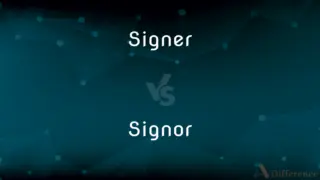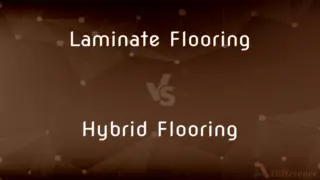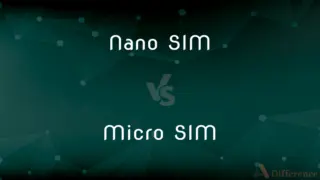Blastocyst vs. Embryo — What's the Difference?
Edited by Tayyaba Rehman — By Fiza Rafique — Updated on September 28, 2023
A Blastocyst is an early-stage embryo that forms about 5 days after fertilization, while an Embryo is the early developmental stage of an organism, from fertilization to the fetus stage. The Blastocyst is a specific phase within the Embryo's development.

Difference Between Blastocyst and Embryo
Table of Contents
ADVERTISEMENT
Key Differences
The journey from conception to birth involves many intricate stages. A Blastocyst is one of the early steps in this developmental ladder, representing a collection of cells that have undergone several divisions post-fertilization. In contrast, an Embryo represents a broader timeframe in development, encompassing multiple stages, with the Blastocyst being one of them.
When a sperm fertilizes an egg, it forms a zygote. As this zygote starts to divide, it progresses through various stages. Around 5 days post-fertilization, it transforms into a Blastocyst. The Embryo, on the other hand, is a term that covers the entire developmental spectrum from the moment of fertilization to the point just before it becomes a fetus.
The Blastocyst is distinguishable due to its hollow structure, housing an inner cell mass that eventually gives rise to the organism's body. The term Embryo, meanwhile, covers a myriad of changes, transformations, and growth patterns as cells differentiate and take on specialized roles.
Comparison Chart
Definition
A specific stage post-fertilization with a hollow structure.
Developmental stage from fertilization until the fetus phase.
Duration
Occurs around 5 days after fertilization.
Extends from fertilization to the end of the 8th week in humans.
ADVERTISEMENT
Structure
Hollow with an inner cell mass.
Goes through multiple structures as it develops organs and systems.
Role
Precursor to implantation in the uterus.
Develops into a fully formed organism.
Complexity
Specific, early-stage development.
Encompasses various stages, including the blastocyst phase.
Compare with Definitions
Blastocyst
The stage following the morula in embryonic development.
The transition from morula to Blastocyst is marked by cavity formation within the cell mass.
Embryo
The developing organism from fertilization to the fetal stage.
The heart is one of the first organs to develop in the Embryo.
Blastocyst
An early stage in mammalian embryogenesis.
After in-vitro fertilization, the cells form a Blastocyst before implantation.
Embryo
The precursor to a fetus in mammalian development.
The transition from Embryo to fetus is marked by the end of the 8th week in human pregnancies.
Blastocyst
A hollow cellular mass that forms after several days of cell division.
A healthy Blastocyst has a higher chance of successful implantation in the uterus.
Embryo
A multicellular entity in its primitive phase of development.
Research on Embryo development provides insights into human growth and disorders.
Blastocyst
A structure formed in the early development of mammals.
The Blastocyst's inner cell mass is essential for the formation of the embryo proper.
Embryo
The phase following fertilization where cells differentiate and organs form.
The Embryo's neural tube will eventually develop into the brain and spinal cord.
Blastocyst
The blastocyst is a structure formed in the early development of mammals. It possesses an inner cell mass (ICM) which subsequently forms the embryo.
Embryo
An early stage in the development of a multicellular organism.
The human Embryo undergoes rapid changes in the first few weeks after conception.
Blastocyst
The modified blastula that is characteristic of placental mammals. Also called blastodermic vesicle.
Embryo
An embryo is the early stage of development of a multicellular organism. In general, in organisms that reproduce sexually, embryonic development is the part of the life cycle that begins just after fertilization and continues through the formation of body structures, such as tissues and organs.
Blastocyst
(biology) The mammalian blastula
Embryo
The collection of cells that has developed from the fertilized egg of a vertebrate animal, before all the major organs have developed.
Blastocyst
The germinal vesicle.
Embryo
A collection of such cells of a human, especially from implantation in the uterine wall through the eighth week of development.
Blastocyst
The blastula of mammals
Embryo
(Botany) The young sporophytic plant contained within a seed or an archegonium.
Blastocyst
A precursor to the implanted embryo in the uterus.
The outer cells of the Blastocyst attach to the uterine lining, initiating implantation.
Embryo
An organism at any time before full development, birth, or hatching.
Embryo
A rudimentary or beginning stage
An idea that was the embryo of a short story.
Embryo
In the reproductive cycle, the stage after the fertilization of the egg that precedes the development into a fetus.
Embryo
An organism in the earlier stages of development before it emerges from the egg, or before metamorphosis.
Embryo
In viviparous animals, the young animal's earliest stages in the mother's body
Embryo
In humans, usually the cell growth of the child within the mother's body, through the end of the seventh week of pregnancy
Embryo
(botany) A rudimentary plant contained in the seed.
Embryo
(figurative) The beginning; the first stage of anything.
Embryo
The first rudiments of an organism, whether animal or plant
Embryo
Pertaining to an embryo; rudimentary; undeveloped; as, an embryo bud.
Embryo
(botany) a minute rudimentary plant contained within a seed or an archegonium
Embryo
An animal organism in the early stages of growth and differentiation that in higher forms merge into fetal stages but in lower forms terminate in commencement of larval life
Common Curiosities
Why is the Blastocyst's inner cell mass significant?
The inner cell mass of the Blastocyst gives rise to the actual body of the organism.
Can you have an Embryo without a Blastocyst stage?
No, the Blastocyst stage is a necessary phase in the development of an Embryo.
What structures form during the Embryo phase?
During the Embryo phase, primitive organs and structures like the neural tube, heart, and limb buds begin to form.
How long does the Blastocyst stage last?
The Blastocyst stage is brief, usually forming around 5 days post-fertilization in humans.
Is every Embryo a Blastocyst at some point?
Yes, the Blastocyst is a stage within the Embryo's development.
Is the Blastocyst stage longer than the Embryo stage?
No, the Blastocyst is a brief stage within the longer Embryo phase.
What follows after the Blastocyst stage?
After the Blastocyst stage, implantation occurs, and the Embryo continues its development.
When does an Embryo become a fetus?
In humans, an Embryo becomes a fetus at the end of the 8th week post-fertilization.
Share Your Discovery

Previous Comparison
Islam vs. Bahai
Next Comparison
Bandwidth vs. FrequencyAuthor Spotlight
Written by
Fiza RafiqueFiza Rafique is a skilled content writer at AskDifference.com, where she meticulously refines and enhances written pieces. Drawing from her vast editorial expertise, Fiza ensures clarity, accuracy, and precision in every article. Passionate about language, she continually seeks to elevate the quality of content for readers worldwide.
Edited by
Tayyaba RehmanTayyaba Rehman is a distinguished writer, currently serving as a primary contributor to askdifference.com. As a researcher in semantics and etymology, Tayyaba's passion for the complexity of languages and their distinctions has found a perfect home on the platform. Tayyaba delves into the intricacies of language, distinguishing between commonly confused words and phrases, thereby providing clarity for readers worldwide.















































